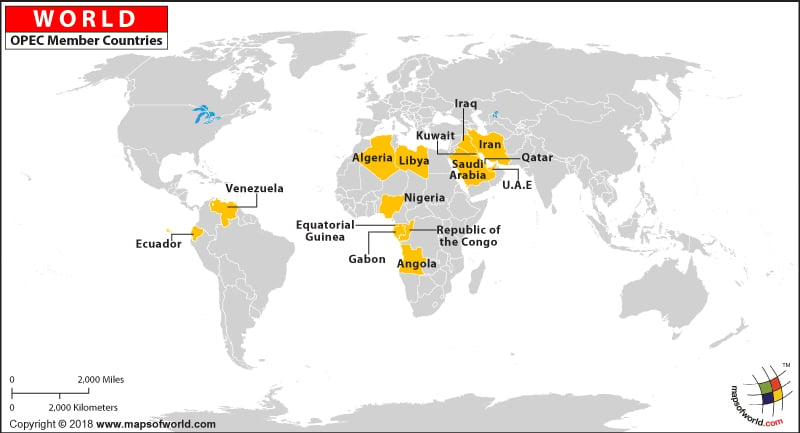| OPEC Member Countries |
| Country | Region | Membership Years | Population (2016 est.) | Area (km2) | Oil Production (bbl/day, 2016) | Proven Reserves (bbl, 2016) |
|---|---|---|---|---|---|---|
| Algeria | North Africa | 1969 | 4,06,06,052 | 23,81,740 | 13,48,361 | 12,20,00,00,000 |
| Angola | Southern Africa | 2007 | 2,88,13,463 | 12,46,700 | 17,69,615 | 8,42,30,00,000 |
| Ecuador | South America | 1973-1992, 2007 | 1,63,85,068 | 2,83,560 | 5,48,421 | 8,27,30,00,000 |
| Equatorial Guinea | Central Africa | 2017 | 12,21,490 | 28,051 | 2,27,000 | 1,10,00,00,000 |
| Gabon | Central Africa | 1975-1995, 2016 | 19,79,786 | 2,67,667 | 2,10,820 | 2,00,00,00,000 |
| Iran | Middle East | 1960 | 8,02,77,428 | 16,48,000 | 39,90,956 | 1,57,53,00,00,000 |
| Iraq | Middle East | 1960 | 3,72,02,572 | 4,37,072 | 44,51,516 | 1,43,06,90,00,000 |
| Kuwait | Middle East | 1960 | 40,52,584 | 17,820 | 29,23,825 | 1,01,50,00,00,000 |
| Libya | North Africa | 1962 | 62,93,253 | 17,59,540 | 3,84,686 | 48,36,30,00,000 |
| Nigeria | West Africa | 1971 | 18,59,89,640 | 9,23,768 | 19,99,885 | 37,07,00,00,000 |
| Qatar | Middle East | 1961-2019 | 25,69,804 | 11,437 | 15,22,902 | 25,24,40,00,000 |
| Republic of the Congo | Central Africa | 2018 | 51,25,821 | 3,42,000 | 2,60,000 | 1,60,00,00,000 |
| Saudi Arabia | Middle East | 1960 | 3,22,75,687 | 21,49,690 | 1,04,60,710 | 2,66,57,80,00,000 |
| United Arab Emirates | Middle East | 1967 | 92,69,612 | 83,600 | 31,06,077 | 97,80,00,00,000 |
| Venezuela | South America | 1960 | 3,15,68,179 | 9,12,050 | 22,76,967 | 2,99,95,30,00,000 |
| OPEC Total | 48,36,30,000 | 1,24,92,695 | 3,54,81,740 | 12,10,70,30,00,000 | ||
| World Total | 7,66,88,52,000 | 51,00,72,000 | 8,06,22,287 | 16,50,58,50,00,000 | ||
| OPEC Percent | 6.30% | 2.40% | 44% | 73% |
The OPEC member countries map shows a World Map, where all the member countries of OPEC have been highlighted.
OPEC stands for the Organization of the Petroleum Exporting Countries. It was founded in 1960, in Baghdad by the first five members - Iran, Iraq, Kuwait, Saudi Arabia, and Venezuela. Since 1965, OPEC is headquartered in Vienna, Austria.
The mission of OPEC is to coordinate and unify petroleum policies of Member Countries. OPEC is made up of fifteen countries – Angola, Algeria, Equatorial Guinea, Republic of the Congo, Gabon, Indonesia, Iran, Iraq, Kuwait, Libya, Nigeria, Qatar, Saudi Arabia, the United Arab Emirates, and Venezuela. Qatar will however, no longer be a member of OPEC from January 1, 2019. 81.5% of the world's "proven" oil reserves are found in these countries.
The organization aims at coordinating and unifying petroleum policies of its member countries. OPEC also aims at stabilizing prices in the international oil markets. It wants to secure a steady income to the producing countries. OPEC decisions play a significant role in the global oil market and international relations.
The Representatives of OPEC Member Countries (Heads of Delegation) get together at the OPEC Conference to co-ordinate and unify petroleum policies. Their aim is to promote stability and harmony in the oil market. As of September 2018, about 44 per cent of the world's oil output comes from the OPEC member countries. They possess more than three-quarters of the world's total proven crude oil reserves.
Last Updated : February 25, 2020
| Other Links |





